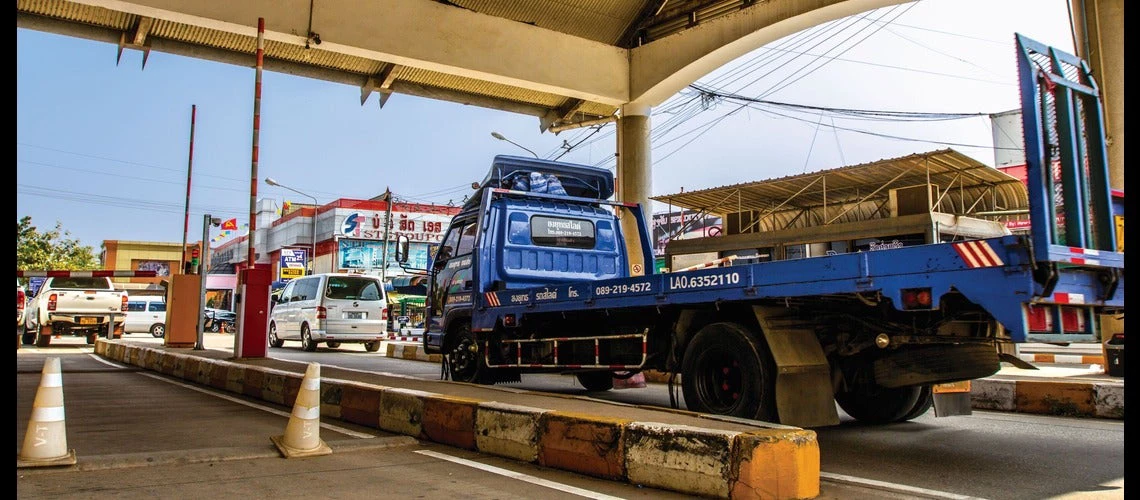 An empty Thai truck enters Laos at the Friendship Bridge border, near Vientiane.
An empty Thai truck enters Laos at the Friendship Bridge border, near Vientiane.
The recent launch of an Authorized Economic Operator (AEO) program in the Lao PDR can speed up processes and reduce the costs of international trade for local companies, a crucial advance as the country looks to benefit from new infrastructure and its location in central Southeast Asia. Under the program, traders who voluntarily work with national customs authorities are classified as Authorized Economic Operators, and face significantly less border examination than regular traders. To gain full benefit, the authorities need to use daily results to fine tune the system, and attract more companies to the scheme.
For Laos, economic growth is linked to global and regional economic integration. As a small land-locked country, it relies on international trade, exporting commodities and importing inputs for small and medium enterprises (SMEs), along with consumer goods.
The World Bank is supporting Lao government efforts to progressively introduce measures that improve and streamline the processing and clearance of goods at its borders. The AEO program marks a significant step in this direction, helping to facilitate legitimate trade and improve the security of international supply chains.
The AEO concept is based on the Customs-to-Business partnership introduced by the World Customs Organization under its Framework of Standards to Secure and Facilitate Global Trade. The Lao Customs Department initiated its AEO program in 2016 with a two-year preparatory phase that assessed business readiness and prepared a strategy, with support from the World Bank-financed Customs and Trade Facilitation Project. This was followed by a setup phase to establish a legal and regulatory framework, implementation guidelines, and standard operating procedures. This phase, which also featured training modules, was supported by the International Finance Corporation’s Investment Climate Advisory Project.
In February 2023, the first Lao company received AEO accreditation. Accredited companies that maintain a track record of regulatory compliance benefit from preferential measures at the border, including fewer physical inspections, faster release times, reduced documentation requirements, and deferred payment of duties, taxes, and fees. Local companies engaged in international supply chain activities, such as manufacturers, importers, cargo terminal operators, freight forwarders, warehouse operators and exporters, are eligible.
To gain optimum benefits from the AEO initiative, Laos needs to encourage more SMEs to participate. Experience from other developing countries suggests that multinational and large companies are often better prepared to meet AEO requirements and can therefore gain accreditation more quickly. To encourage more SMEs, the Customs Department could facilitate access to information through outreach campaigns, social media, and traditional means such as leaflets, posters, and brochures. At the same time, the application and approval process could be improved by training more customs officers to help candidate firms better understand and meet the criteria. Ultimately, it must be apparent that the benefits for AEO-accredited firms are sufficient to make participation attractive, and World Bank program activities are currently expanding dissemination efforts.
The Customs Department also needs to maintain a regular review process to ensure that participating firms maintain high standards of compliance. An effective risk management system is one of the core elements of all AEO programs. In Laos, imported cargo is classified by three levels of perceived risk; red for high-risk cargo, yellow for medium-risk cargo, and green for low-risk cargo. In principle, ‘green’ cargo qualifies for release from customs control without documentary and physical inspection, while cargo categorized as yellow is subject to documentary checks. ‘Red’ cargo is considered high risk and is subject to physical examination.
Currently, the Customs Department uses the ASYCUDA selectivity module to assign risk categories based on a series of profiles. An effective management system relies on the regular update of risk profiles based on documentary and physical examinations, intelligence, and the results of post-clearance audit action. Inspection results must be fed back into the system, and risk profiles need regular review. The Customs Department does not yet regularly review risk profiles based on inspection results and data. This lack of a formalized feedback loop means that customs officers have low confidence in the risk categorization given by ASYCUDA and frequently reassign declarations based on their own knowledge and experience. To achieve high regulatory compliance and deliver meaningful benefits for compliant traders, feedback and review must be thorough.
The World Bank Group is working with the Lao Customs Department to develop and implement an integrated risk management framework that ensures sound risk management practices are followed by customs, quarantine and food safety border agencies. To achieve this goal, the Customs Department will need to improve its risk management practices and help the other agencies contribute to the wider integrated risk management framework. Such an approach will ensure the Lao PDR’s cross-border regulatory requirements are met, and also make trading easier for low-risk firms.



Join the Conversation